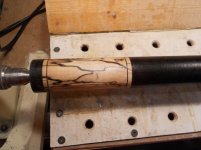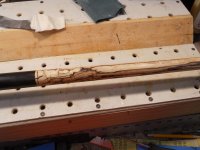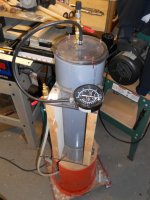How about curly mango ?
What size would they be best in getting stabilized.
Joey I cut mango a little oversized and it stabilizes a lot like koa. Not much twisting and warping but I still go about 1.75 square to be safe. It will add significant weight....
Might as well respond to the OP here as well, so I don't have to retype this again.
1). Make sure your wood is dry under 10% moisture level.
2). Cut it oversized to be safe, in case it does warp or twist when it cures.
3). The 2 companies I use, are WSSI (Wood Stabilizing Specialist Inc) in Ionia Iowa and K/G (Knife and Gun Supply) in Arizona. (Google for their sites)
4). Depending on species etc, I decide where to send what.... For Redwood Burl I would send to K/G in Arizona.
5). I do not work for, or receive any compensation from either of those companies, so my endorsement of their services is based on my being happy with their stabilizing services. I don't even get a discount......
6). If I was just starting out I would send a call sized blank (2 x 2 x 6) of some burl or whatever to some pro companies out there and see which you like the best. I think River Ridge used to offer to a single block for free if you pay postage, I dunno if that is still is an option or not.
7) Try them out, test the results --->
a) Did the dye or stabiliant go all the way thru? Using the dye is an easy way to tell...
b) What did the block weigh before versus after.... (if you use the same piece of wood ( say an 18" piece cut into 3 smaller pieces) for all the companies it will tell you how much stabilant was retained at the cellular level ....meaning which process was more successful at getting the wood cells to fill with the stabilant
c). Does the block float or sink in water? Can you soak for 24 hrs with no effect. Water makes wood move.... so does it swell? When it dries, does it shrink?
d). Could you dent the wood with a thumbnail before you sent it in, and can you dent it now that it has been processed? In other words, is it now hard? think spalted / box elder etc....
e). Is the dye color bright and brilliant or is it kind of faded and sort of pastel looking...? On the inside and the outside of the piece ? What look do you prefer?
f) I have seen some guys send blocks thru the dishwasher, and leave them outside during the winter time exposed to snow and rain, etc. TEST TEST TEST....
Then decide for yourself what you like best.... For the DIY folks who still want to create a chamber, I have the PDF instructions for valve configurations for the paint pot. Probably still on the net as well. I can look for it if anyone is interested. It allowed vac and pressure using the same lid with 2 diff valves. Could be reused for a fabbed tank for longer pieces...
There is also a bunch of new stabilant on the market as well... Some of them are as runny as water, and harden well if it can be pushed through the wood.
FYI....There is a company out there that is saying they can successfully stabilize cocobolo which normally wont stabilize well because of the oil content...



